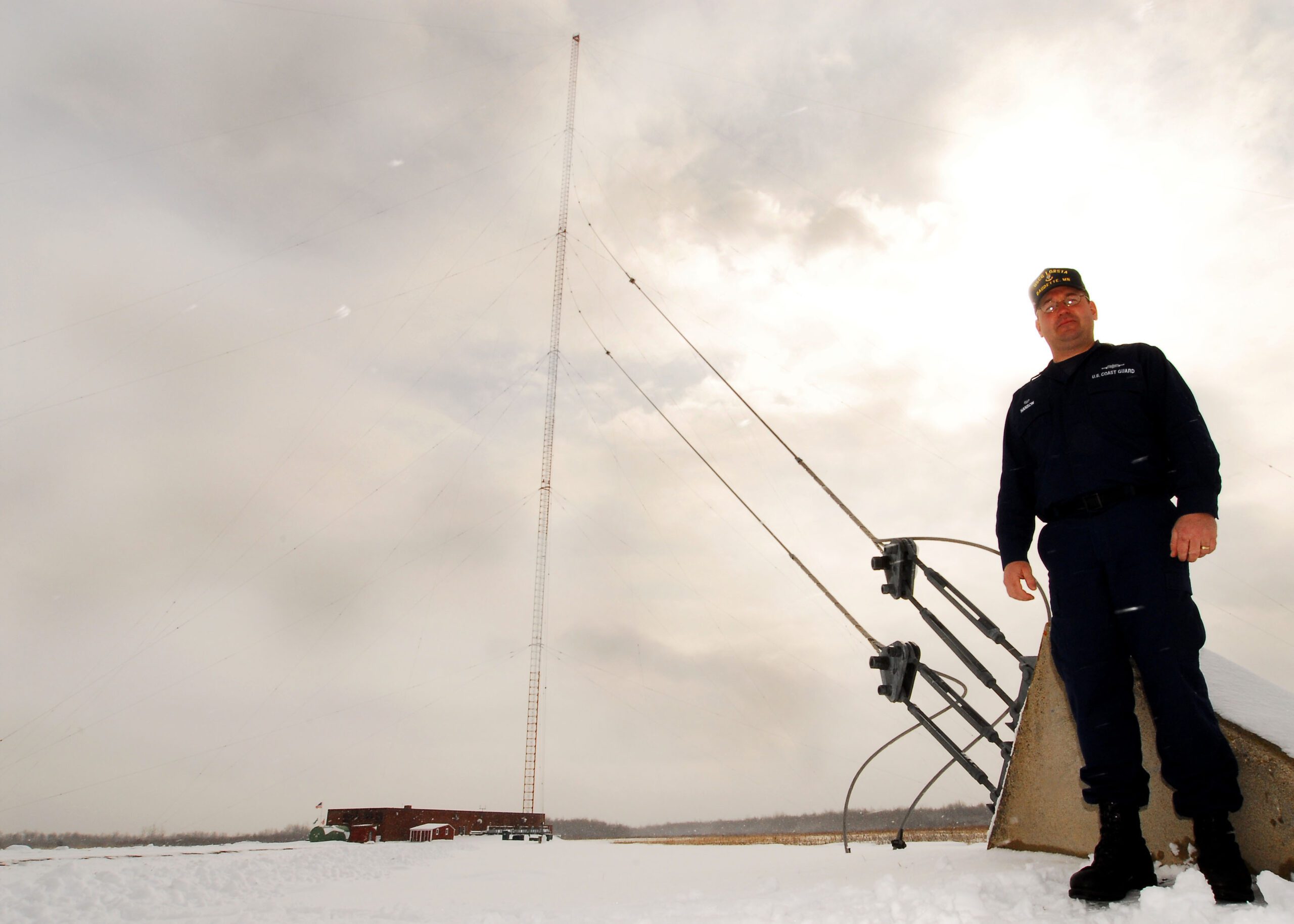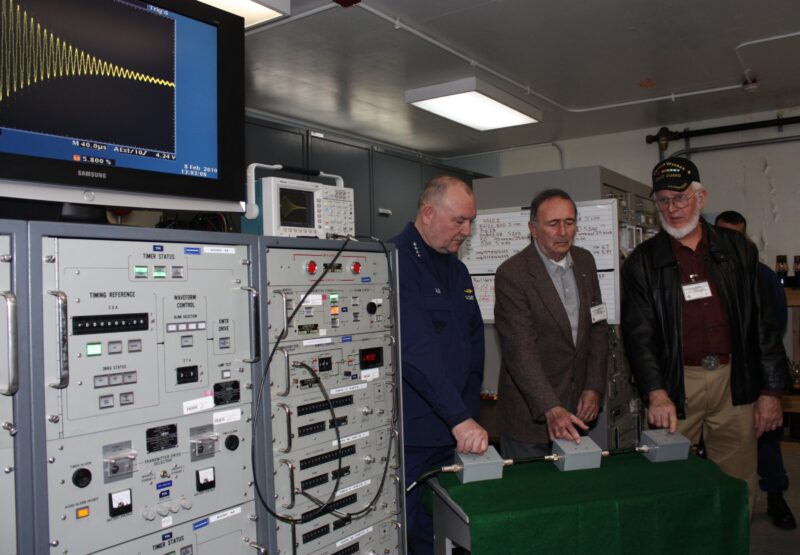The Harsh Reality of US Coast Guard Migrant Policy
by John Konrad (gCaptain) When merchant and cruise ships rescue migrants at sea, they offer more than just a lifeline from the perilous waters; they provide critical sustenance and care....


Chief Thomas Hanson savored his final days at the Long-Range Navigation Station Baudette, which he has called home for the past 11years, April 2, 2008. Hanson is months away from retirement after spending half his career at isolated Long-Range Navigation Stations like this one. Photo by PA3 William Mitchell.
by John Konrad, K5HIP (gCaptain) Loran-C was an incredibly reliable and accurate analog ground-based navigation system, operated by the US Coast Guard. Despite its impressive performance, it had some drawbacks, such as limited coverage, expensive infrastructure requirements, and the need to maintain a large number of radio stations in remote areas. Now with concerns over GPS jamming and hacking should we consider rebuilding the United State’s once robust system of Loran-C stations?
Prior to its decommissioning in 2010, then-USCG Commandant Thad Allen proposed upgrading the system to E-Loran, a digitalized and automated version of Loran-C that would provide improved accuracy and resistance to jamming and other forms of interference. However, due to a lack of Pentagon concern regarding a potential technology or space war with China and vulnerabilities to Russian hackers at the time, Congress did not fund the proposal and the old Loran stations were removed from service. In order to implement future upgrades, the entire Loran network of stations would need to be rebuilt.
Several countries, including the United Kingdom and Russia, have continued investing in developing E-Loran systems. However, despite the potential benefits of E-Loran, it has not been widely adopted and is not currently in use as a backup to GPS.
The death blow to E-Loran came due to a total lack of interest from Silicon Valley who in 2010 – before the advent of crowd-sharing networks like Uber – favored bits over atoms and mostly did not believe that tiny devices like a cell phones – which work on very short wavelength radio frequencies – could process the large wavelength transmissions of a high-frequency radio system like Loran.
Also read: eLORAN 101 – The Return Of LORAN C?


Today however, high-frequency capable chips are ubiquitous – you can decode HF navtex and DSD signals with a $30 dongle from Amazon – and the benefits of E-Loran could be substantial. What benefits? First and foremost is penetration. Right now phone use advanced processing and signal intelligence to augment GPS to provide a location when you enter a parking garage, building, or even hike in dense foliage. This is required because GPS signals use short wavelengths that don’t penetrate structures very well. Loran signals – with their large wavelengths that travel great distances – do.
Also Read: LORAN Overboard
Some of the advantages of Loran-C over GPS were:
In the United States, the Department of Homeland Security (DHS) conducted a study on the feasibility of establishing an E-Loran system as a backup to GPS in 2008. The study concluded that E-Loran had significant potential as a backup system, but the implementation of the system would require significant investment and support from the private sector. Despite the promising results of the study, the E-Loran system was not implemented as a backup to GPS in the United States due to budget constraints and a lack of interest from the private sector.
Also read: eLoran Sparks Debate In Washington – Is It Truly Important?


With space savvy adversaries like Russia and China becoming increasingly aggressive the Department of Defense has started to reinvest in High Frequency communication systems. While the US Navy and US Coast Guard continue to have limited interest in terrestrial based radio, the US Air Force is investing heavily in “old” radio sytems. Just last year the US Air Force, in partnership with BAE Systems, awarded a $176m contract to Ham Radio manufacturer FlexRadio to return HF radio to the cockpits of it’s aircraft and Ukraine is using ham radios to communicate behind enemy lines. What’s old is new again but rebuilding the entire Loran system would require puchasing land, running millions of miles of cable, installation of new radio infrastructure, and training of personnel to operate and maintain the system. This cost would far exceed the few hundred million the USAF is investing in HF.
The Loran system could be rebuilt in densely populated areas with existing infrastructure for less but coverage would be limited. So is there a better way?
FT8 is a digital mode of communication used by amateur radio operators for making radio contacts over long distances. It was developed by Nobel prize winning physicist Joe Taylor (K1JT) and ham radio operator Steve Franke (K9AN) as part of the WSJT-X software suite for amateur radio communications.
FT8 is designed for weak signal communications and is particularly useful for making contacts under poor propagation conditions, such as during times of low solar activity or when atmospheric noise is high. The mode uses internet synchronized clocks a fixed-length transmission of 15 seconds, during which the transmission is spread out over multiple subcarriers, providing a high degree of error correction.
FT8 is characterized by its highly automated operation, where the operator simply selects a frequency, sets the transmit power, and lets the software handle the rest. The software performs an exchange of information between the two stations, and the operator receives a confirmation of a successful contact.
FT8 has gained popularity among amateur radio operators due to its ease of use, high degree of error correction, and ability to make contacts over long distances under poor propagation conditions. It is commonly used for weak signal digital modes in the HF bands, such as 6 meters, 2 meters, and 70 centimeters. Today thousands of stations transmit time-synchronized FT8 signals from fixed stations around world that provide reach to every corner of the planet.
Building out a new E-Loran system would likely be too expensive for even the most well funded defense organizations like the DoD or NATO but, with Ham radio operators already emitting accurate time synchronized HF signals from fixed transmitting locations it’s possible to triangulate a position already. The problem is noisy. Are all the clocks of these ham radio operators perfectly synchronized? Are they all transmitting from their stated locations? What if a HAM radio operator moves and doesn’t update his position with the FCC or operates FT8 from a mobile RV or boat?
This is where AI could help. It is possible for AI to watch out for inaccuracies in the system. It could monitor stations over a long period of time and rate them on their accuracy and signal strength. It could flag and remove errant signals. This, of course, all requires a lot of processing power but each iPhone is more powerful than any supercomputer when GPS was invented.
The programing would be a challenge too but with a Nobel Laureate like Dr. Joe Taylor, intelligent Hams, equipment manufacturers like FlexRadio and Elecraft, assistance from Apple and Google Oceans and DoD funding it should be possible to harness the system for navigational purposes and provide a redundant backup to GPS while allowing for better locational coverage for our phones.
In conclusion, rebuilding the Loran-C system is a feasible endeavor, albeit one that would require a considerable amount of investment, time, and expertise. This is not an insurmountable task, however, considering the most popular and revolutionary ship location tracking technology of today – web based AIS systems like Marine Traffic – already utilizes ham radio receive stations around the world, and has proven to be a reliable and invaluable asset to the shipping industry. A radio-based navigation system like E-Loran would necessitate licensed and regulated radio transmitters, but luckily, thousands of these stations are already running FT8 on every continent, making it possible to crowd-source an HF navigational alternative to GPS, eliminating the need for the USCG to acquire land and maintain stations. And if the existing equipment isn’t accurate enough, the US Navy and USCG could help FlexRadio develope new ham hardware.
At least theoretically.
Join the gCaptain Club for curated content, insider opinions, and vibrant community discussions.


Join the 107,035 members that receive our newsletter.
Have a news tip? Let us know.
Access exclusive insights, engage in vibrant discussions, and gain perspectives from our CEO.
Sign Up




Maritime and offshore news trusted by our 107,035 members delivered daily straight to your inbox.



Essential news coupled with the finest maritime content sourced from across the globe.
Sign Up